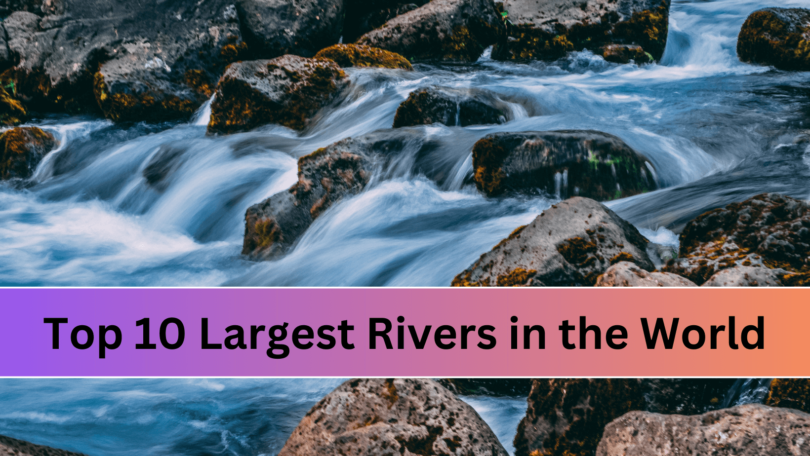In this article, we explore the top 10 largest rivers in the world based on their length, traversing multiple countries and offering a glimpse into the geographical diversity that defines our planet.
Rivers, the lifeblood of our planet, have carved their way through landscapes, cultures, and histories for millennia.
These majestic waterways have played a crucial role in shaping civilizations and ecosystems alike.
Largest Rivers
1.Nile River
- Length: Approximately 4,135 miles (6,650 kilometers)
- Countries: Egypt, Sudan, South Sudan, Ethiopia, Uganda, Congo, Kenya, Tanzania, Rwanda, Burundi, Eritrea

Description: The iconic Nile River is a symbol of life and fertility in the Egyptian desert. Flowing through several African nations, it sustains millions with water, agriculture, and transportation, while its historical significance is deeply interwoven with the region’s cultural heritage.
2. Amazon River
- Length: Approximately 4,225 miles (6,800 kilometers)
- Country: Brazil, Peru, Colombia

Description: The Amazon River, snaking through dense rainforests, is the world’s largest river by discharge volume. It’s a biodiversity hotspot, teeming with unique flora and fauna, and its vast basin is home to countless indigenous communities.
3. Yangtze River (Chang Jiang)
- Length: Approximately 3,917 miles (6,300 kilometers)
- Country: China

Description: The Yangtze River is China’s longest river and plays a crucial role in the country’s history and development. Its Three Gorges Dam is the world’s largest hydroelectric power station, providing energy and flood control.
4. Mississippi-Missouri River System
- Length: Approximately 3,902 miles (6,275 kilometers)
- Country: United States

Description: Combining the Mississippi and Missouri rivers, this system is the backbone of American trade and transportation. It has influenced the country’s expansion, commerce, and cultural heritage.
5.Yenisei-Angara-Irkutsk River System
- Length: Approximately 3,445 miles (5,539 kilometers)
- Country: Russia

Description: The Yenisei River flows through Siberia, providing an essential water route in a remote region. The Angara River originates from Lake Baikal, the world’s deepest freshwater lake, making this system ecologically unique.
6.Yellow River (Huang He)
- Length: Approximately 3,395 miles (5,464 kilometers)
- Country: China

Description: Often referred to as “China’s Sorrow” due to its historical tendency to flood, the Yellow River is nonetheless vital for agriculture and is associated with China’s early civilizations.
7. Ob-Irtysh River System
- Length: Approximately 3,364 miles (5,410 kilometers)
- Country: Russia, Kazakhstan, China, Mongolia

Description: The Ob and Irtysh rivers form an extensive system that drains into the Arctic Ocean. These rivers serve as important trade routes, and their watershed covers diverse landscapes.
8.Parana-Paraguay River System
- Length: Approximately 3,030 miles (4,880 kilometers)
- Country: Argentina, Brazil, Paraguay

Description: The Parana and Paraguay rivers crisscross South America, contributing to the region’s biodiversity and economy. The Iguazu Falls, part of this system, are a stunning natural wonder.
9. Congo River
- Length: Approximately 2,922 miles (4,700 kilometers)
- Countries: Democratic Republic of Congo, Republic of Congo

Description: The Congo River is the second-largest in terms of discharge volume. Its vast basin is home to rich rainforests and diverse wildlife, though transportation along the river remains challenging due to its rapids.
10. Amur-Argun River System
- Length: Approximately 2,763 miles (4,440 kilometers)
- Countries: Russia, China

Description: The Amur River forms a natural border between Russia and China. This river system supports diverse ecosystems and plays a crucial role in regional economies.
The world’s largest rivers are more than mere watercourses; they are the veins through which life pulses across landscapes and cultures.
Spanning continents, these mighty waterways reflect the beauty and power of nature, shaping the past, present, and future of humanity and the planet.
As we appreciate their significance, we are reminded of the delicate balance between human development and the preservation of these irreplaceable natural treasures.









Super
Thank You